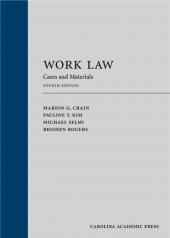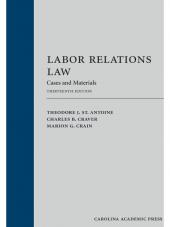Work Law: Cases and Materials
Select subscription type
Terms & conditions
Subscribers receive the product(s) listed on the Order Form and any Updates made available during the annual subscription period. Shipping and handling fees are not included in the annual price.
Subscribers are advised of the number of Updates that were made to the particular publication the prior year. The number of Updates may vary due to developments in the law and other publishing issues, but subscribers may use this as a rough estimate of future shipments. Subscribers may call Customer Support at 800-833-9844 for additional information.
Subscribers may cancel this subscription by: calling Customer Support at 800-833-9844; emailing customer.support@lexisnexis.com; or returning the invoice marked "CANCEL".
If subscribers cancel within 30 days after the product is ordered or received and return the product at their expense, then they will receive a full credit of the price for the annual subscription.
If subscribers cancel between 31 and 60 days after the invoice date and return the product at their expense, then they will receive a 5/6th credit of the price for the annual subscription. No credit will be given for cancellations more than 60 days after the invoice date. To receive any credit, subscriber must return all product(s) shipped during the year at their expense within the applicable cancellation period listed above.
Subscribers receive the product(s) listed on the Order Form and any Updates made available during the annual subscription period. Shipping and handling fees are not included in the annual price.
Subscribers are advised of the number of Updates that were made to the particular publication the prior year. The number of Updates may vary due to developments in the law and other publishing issues, but subscribers may use this as a rough estimate of future shipments. Subscribers may call Customer Support at 800-833-9844 for additional information.
Subscribers may cancel this subscription by: calling Customer Support at 800-833-9844; emailing customer.support@lexisnexis.com; or returning the invoice marked 'CANCEL'.
If subscribers cancel within 30 days after the product is ordered or received and return the product at their expense, then they will receive a full credit of the price for the annual subscription.
If subscribers cancel between 31 and 60 days after the invoice date and return the product at their expense, then they will receive a 5/6th credit of the price for the annual subscription. No credit will be given for cancellations more than 60 days after the invoice date. To receive any credit, subscriber must return all product(s) shipped during the year at their expense within the applicable cancellation period listed above.
Product description
View a sample of this title using the ReadNow feature
To purchase a printed version of this title, please visit www.caplaw.com.
The law of work has evolved as a patchwork of legal interventions in the labor market, sometimes by statute, and sometimes through the common law of judicial decisions. Most law school curricula divide the law of work into three topical areas—Labor Law, Employment Law, and Employment Discrimination—and offer separate courses in each area. Labor law in the United States is understood to encompass the study of the National Labor Relations Act, the law governing union organizing and collective bargaining. It is the law of collective rights at work. Employment law refers to the statutes and common law governing individual rights at work. It ranges from minimum standards legislation to judicially created doctrines based in tort and contract law. Employment discrimination law deals with the statutes and interpretative case law advancing the antidiscrimination norm in the workplace. These statutes address the problem of status discrimination at work (e.g., discrimination on the basis of race, sex, national origin, ethnicity, religion, disability, or sexual orientation).
This book offers a comprehensive view of the law governing the work relationship by touching on all three topical areas. The book treats individual employment rights in depth, and is most appropriate for an Employment Law course or a broad survey course. The book also adverts to Labor Law principles at a number of points, at a policy level rather than a doctrinal level, as a way of introducing and evaluating an alternative model of employee representation; the book does not assume any knowledge of Labor Law on the part of teacher or student and makes no effort to provide a satisfactory substitute for a Labor Law text. The book offers some detail in the law of Employment Discrimination but does so primarily with an eye toward surveying the field and assessing antidiscrimination regulation as a response to an increasingly diverse workforce, rather than providing an in-depth study of Employment Discrimination principles.
The fourth edition of Work Law: Cases and Materials incorporates new developments in a variety of areas:
- A new case, Cotter v. Lyft, on the boundaries of the employment relationship in the context of the gig economy;
- A new case on promissory estoppel as a limit on employment-at-will, Cocchiara v. Lithia Motors, Inc.;
- New cases on nonsolicitation agreements (Bankers Life & Casualty Co. v. American Senior Benefits) and the duty of loyalty (Salas v. Total Air Services);
- Expanded materials reflecting recent developments in the use of electronic monitoring and data analytics in the workplace;
- Updated coverage and a new problem on public employee speech in the internet age;
- Updated coverage of legal issues surrounding employee voice under the NLRA, including the social media case Triple Play Sports Bar & Grille, and treatment of the impact of the Labor Board’s decision in Boeing, Inc. on employer restrictions on collective action;
- A new disability discrimination case, Hostettler v. College of Wooster, on reasonable accommodation;
- Coverage of the #MeToo movement and its implications, and discussion of race-specific hiring in the context of the musical Hamilton;
- Streamlined and updated treatment of the Fair Labor Standards Act, including a new case on the status of interns and trainees, Benjamin v. B&H Educ. Inc., and updated materials on overtime pay eligibility; and
- Updated materials on arbitration of employment disputes, including Roe v. SFBSC Management, a new unconscionability case involving erotic dancers, and the Court’s treatment of pre-dispute waivers of class claims in Epic Systems Corp. v. Lewis.
epub is protected by Adobe DRM.
eBooks, CDs, downloadable content, and software purchases are noncancelable, nonrefundable and nonreturnable. Click here for more information about LexisNexis eBooks. The eBook versions of this title may feature links to Lexis+® for further legal research options. A valid subscription to Lexis+® is required to access this content.
Table of contents
Part One Introduction: Regulating Work
Chapter 1 Origins
Chapter 2 The Contemporary Era —Shifts in The Demographics and Structure of Work
Part Two Balancing Employer And Employee Interests: Individual Versus Collective Responses
Chapter 3 Contracting for Individual Job Security
Chapter 4 Public Policy Protections for Individual Job Security
Chapter 5 Collective Job Security
Chapter 6 Employee Mobility
Chapter 7 Dignitary Interests
Chapter 8 Employee Voice
Part Three Freedom from Discrimination Versus Flexibility
Chapter 9 Employment Discrimination Law
Chapter 10 Challenges to Equality in a Diversifying Workplace
Part Four Government Intervention for the Public Good: Legislating a Safety Net
Chapter 11 The Regulation of Wages and Hours
Chapter 12 Health and Pension Plans —ERISA Regulation
Chapter 13 Health and Safety
Part Five Systems of Justice: Public Versus Private, Collective Versus Individual
Chapter 14 Arbitration of Workplace Disputes
Chapter 15 Self-Regulation
Table of Cases
Index
 Lexis Nexis
Lexis Nexis 



